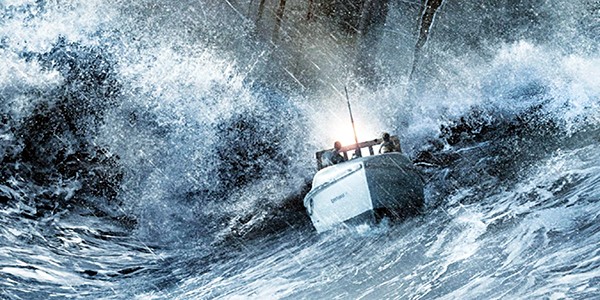They say on the internet that excessive use of sports metaphors is the sign of a weak critic. That’s why the best thing about The Finest Hours is that it allows me to unleash a torrent of nautical metaphors while retaining my final sliver of self-respect. Fortunately for everyone, sailors have many words for failure.
The Finest Hours is becalmed from the beginning, when we see Coast Guard sailor Bernie Webber (Chris Pine) meeting cute with Cape Cod hottie Miriam Pentinen (Holliday Grainger), 1952-style. The movie wants you to believe they’re instantly falling in love, but the two actors mix like oil and water, so the clumsy sequence is just the first of many slow boats to China director Craig Gillespie books us on.

Chris Pine in The Finest Hours
Storm clouds, both real and metaphorical, start to gather about the time Miriam breaches Eisenhower-era patriarchal protocol by asking Bernie to marry her at an especially boring dance. He feeds her a line about asking permission from his commanding officer before a lucky nor’easter blows up and throws our young hero and his crew of misfits into action on the high seas.

A slow boat to boredom
The Finest Hours is based on a true story about the rescue of the crew of the SS Pendleton, an oil tanker that broke apart and sank off the coast of Massachusetts during a powerful storm. In the long history of movies about military heroes, very few, if any, concern the Coast Guard. So it’s kind of a shame that the film adaptation of the service’s bravest exploit is so dreadfully boring and uninspired.
The film’s most compelling moments come onboard the Pendleton, a rusting hulk of a tanker run into disaster by an unseen captain who goes down with the first half of his ship. The group of scalawags trapped in the stern of the broken ship find their reticent leader in engine man Ray Sybert (Casey Affleck), whose ingenuity and resolve in keeping half a ship afloat makes him a more compelling character than our alleged hero Webber. Affleck’s performance is this imperfect storm’s sole ray of light, but Pine is the one with the functioning boat, so he gets top billing. The young, untested Bernie’s mad fight through the storm should be the story’s dramatic heart, but it turns into a repetitive slog through the dark waves. There are a few good shots, such as when the tiny boat with the catchy name CG-36500 plunges underwater through giant, pounding waves, but director Gillespie spoils the fun by recycling them too often. For an $80 million Disney production, The Finest Hours‘ effects look singularly unconvincing. The men of the CG-36500 are clearly on a soundstage getting buckets of water thrown on them. Despite the hurricane force winds blowing blinding snow and freezing spray in their faces, they never look cold. Nor do they take common-sense precautions like wearing goggles, or, in Pine’s case, a hat. The one thing they do remember to bring along are clichés, so you won’t be at all surprised when Pine proclaims “Not on my watch!”
Things are bad out on the ocean, but they’re worse on the shore, where Grainger gives the worst performance of the young year. Her character Miriam is a poorly written, off-the-shelf “strong woman,” but Grainger walks her off the plank into harpy territory. Her lame subplot, which involves forgetting her coat and getting stuck in a snowbank, hits low tide when a single tear rolls down her face as she stares, bored, off into the middle distance. For that fleeting moment, it seems that she and the audience are in the same boat.